|
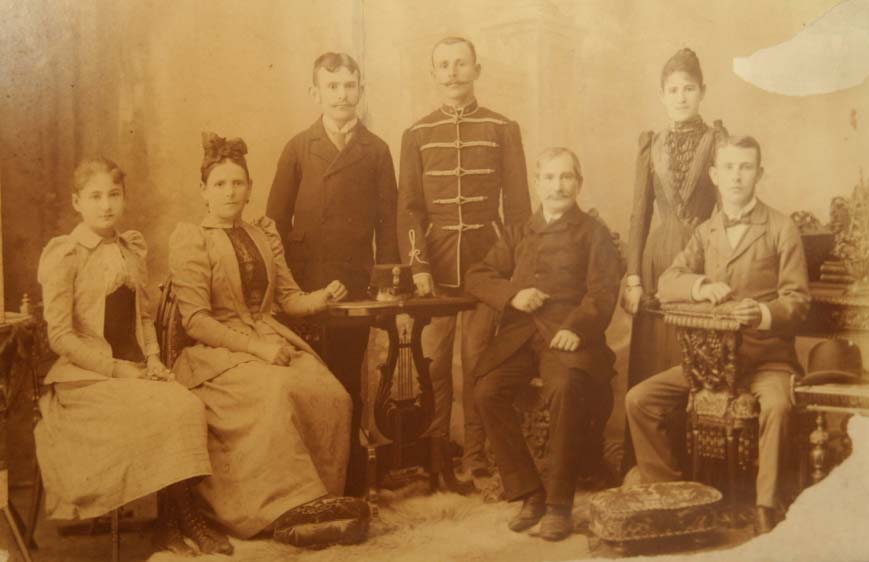
Abraham SIMON with his wife and children (approx. 1885)
[left to right]: Ida, Regina (wife), Jakab, Geza, Abraham, Aranka & Norbert
Genalogical Sources
Unlike any of my other family lines, the
SIMON family has a century-old tradition of family genealogists. In 1901,
my grandmother's Uncle
Geza began a family history diary
documenting the SIMON family back to 1770. Geza's son Zoltan
died in WWII ending his direct lineage, but the family genealogical baton was
passed to his brother Norbert's oldest son Gyula
who passed it on to his youngest sister Magda
who, in turn, passed it on to her daughter and grandson, Agi and Tamas.
Thus the primary source of genealogical
information is Uncle
Geza's Diary which collected the oral history of elders. Geza had no
access to public documents and formulated his amazing account based on the oral
tradition of the family. By the time Gyula, who was a lawyer, took over
stewardship of the family he was able to supplement the history through a
massive amount of public documents he collected in the late 1930's. The
task of reorganizing the information for this new electronic age fell to Magda,
Agi and Tamas.
In that this family history was already so
well documented, my contribution is modest, but I continue to work with ant-like
diligence to add a few nuggets to the family history and to make it available in
English.
Family
Origins
According to my grandmother's Uncle Geza's
diary, the earliest known SIMON was Nachum SIMON
(1770-1850). Nachum was born and died in Topolyhanusfalva in Saros County,
Hungary. Hanusfalva is a village off the river Topoly. This town is now in
Slovakia and called Hanusovce nad Toplou. "He lived in his own farm as a
patriarch, occupying himself with agriculture and cattle
husbandry." Nachum and his wife Jitti had three children: Gerson
(1796-1874), Pál
(1805-1884) and Ózer
(who died in Galszecs). Gerson (1796) was born in Gombosovce also
in Saros nearby to Topolyhanusfalva to the north. His other son Pál was also
born in Topolyhanusfalva in 1904 or Gombosovce in 1810.. Gerzson and his
wife Aranka (1796-1874) had a daughter named Regina (1841-1910). Gerzson was an agricultural
land-leaser. His wife Aranka's was from a well known family of Rabbi's
from Galicia. Pál and his wife Hanna
SUSSMANN had a son named Abraham (1835-1906) aka Adolf in Topolyhanusfalva.
At some point Pál was a restauranteur in Homona, but he backed the wrong side
in the 1848 revolution and his first wife Hani died. He remarried a woman
named Sara and by 1850 he had moved back to Hanusfalva. In 1852 he had
another son named Jakab. By 1869, he was reduced to a modest lifestyle
working as a day laborer for a peasant farmer back in Hanusfalva. Somehow,
the SIMON family began to migrate to Nagyvarad in Transylvania, Bihar County,
Hungary (this area is now known as Oradea, Romania) which was an area of both
economic and cultural opportunity for Jews. Geza's diary says only:
"within the struggles of life by the direction of fate [Abraham] found
himself in Nagyvárad. In Nagyvárad, not much later, he met his cousin
Regina Simon, whom he made his wife on May 8th, 1860."
From the Mormon church film on
Topolyhanusfalva, we know Pál's 2nd
wife Hani died in 1878 in Topolyhanusfalva of a cancer tumor.
Pál (1810) is
listed as married to Sara (1815) in the 1869 census. Abraham
must have moved his father Pal to Nagyvarad after her death, because his father
died in his home in Nagyvarad in 1884.
While the SIMON family clearly came from
Slovakia, prior to moving to Nagyvarad around 1860, they almost certainly came
from Galicia and Poland as did most Hungarian Jews.
Abraham's tombstone lists him as a Levite,
which makes him a descendant of Levi, son of Jacob (Israel) and great
grandfather to Moses. The distinction of being a Levite can only be passed
on from father to son.
Historical Context
Jewish migration from the Pale
Settlement (a part of Poland annexed by Russia with a large Jewish population)
and Galicia towards Transylvania & the Carpathian Rus started between
1750-1850. The 1735-1738 Jewish Census, lists 61 families in Saros county of
which all 61 were of Polish origin. Between 1880 & 1900, the Russians
wishing to rid themselves of the Jews on their newly acquired territory,
conducted pogroms which caused a flood of immigration southward towards Galicia.
Galicia filled with poverty-stricken Jews which caused further migration further
southwards towards Hungary and Transylvania. In 1840, the Hungarian Parliament
granted permission to Jews born in Hungary or those with legal residence to live
where they wanted, own land and establish businesses. In 1848 there was a
revolution where Hungary broke away from the Austrian Empire only to be forced
back into submission in 1849 by the Russian Army. In 1868, the Congress of the Jews proposed a series of reforms
to Jewish institutions and education. The Jewish community split into two
separate communities, the Neolog and the Orthodox, made up of those that agreed
and disagreed with the reforms. In 1868, public
education Act XXXVIII was passed based on proposals by Baron Jozsef Eotvos,
the Minister of Religious Affairs. This act was based on two principles:
compulsory schooling for all, and freedom of choice of instruction. The act
encouraged church sponsored denominational schools (over Hungarian state
schools). In 1873, there was a cholera epidemic swept German and took 190,000
lives in Hungary.
Children
of Abrahám
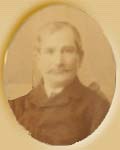 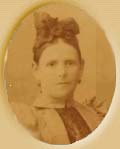 Abrahám
SIMON married his first cousin Regina
SIMON in 1861 in Nagyvarad. Records from the Romanian State Archives
confirm that Adolf and Regina SIMON had several children in Nagyvarad: Chaie
(1864), Geza (1866), Jakab (1867), Jitti (1869), Norbert (1871), Emilia (1873)
and Aranka (1877). In total, they had 7 children of which 5 survived
childhood. Abraham taught at the Auspitz Neolog school in Nagyvarad from
1874 to 1900. These records list the SIMONs living at Kapu Str. 68 in
Nagyvarad in 1875 and then later moving to the suburb of Varalya in 1877. Abrahám
SIMON married his first cousin Regina
SIMON in 1861 in Nagyvarad. Records from the Romanian State Archives
confirm that Adolf and Regina SIMON had several children in Nagyvarad: Chaie
(1864), Geza (1866), Jakab (1867), Jitti (1869), Norbert (1871), Emilia (1873)
and Aranka (1877). In total, they had 7 children of which 5 survived
childhood. Abraham taught at the Auspitz Neolog school in Nagyvarad from
1874 to 1900. These records list the SIMONs living at Kapu Str. 68 in
Nagyvarad in 1875 and then later moving to the suburb of Varalya in 1877.
|
(1) Johanna SIMON (1864-1866)
aka Chaie . Born & died in Nagyvarad at age of 2.
|
|
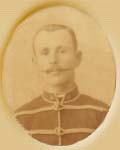 (2) Geza
SIMON (1866), a colorful family character, was a lieutenant of
the hussars. Geza was quite a Don Juan. One night he was forced to
jump out of a second story window when a jealous husband came home
unexpectedly. His leg was badly injured and he had to have several
toes amputated. Due to the injury, he was discharged from the Hussars
and subsequently became a Tobacco company director. On his wedding
day, when Geza married his first wife Aranka, he got a severe cramp in
his leg while walking down the isle which everyone took to be an omen
for the marriage. Geza later divorced Aranka and married a woman named
Ella. No surviving descendants. [Click here
to see a translation of Uncle Geza's 1901 diary.] (2) Geza
SIMON (1866), a colorful family character, was a lieutenant of
the hussars. Geza was quite a Don Juan. One night he was forced to
jump out of a second story window when a jealous husband came home
unexpectedly. His leg was badly injured and he had to have several
toes amputated. Due to the injury, he was discharged from the Hussars
and subsequently became a Tobacco company director. On his wedding
day, when Geza married his first wife Aranka, he got a severe cramp in
his leg while walking down the isle which everyone took to be an omen
for the marriage. Geza later divorced Aranka and married a woman named
Ella. No surviving descendants. [Click here
to see a translation of Uncle Geza's 1901 diary.]
|
|
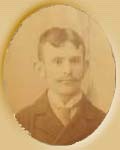 (3)
Jakab SIMON
(1867) was a kind-hearted and generous man who dropped out of school
after getting in a fight with a teacher. He started as an apprentice
in a print shop and eventually became a manager. He married Roza
MAHLER, a singer and supposedly a cousin to the composer Gustav
MAHLER. The SIMON family did not approve of the marriage since Roza
came from a blue collar background. Only his brother Geza came to the
wedding. His father Abraham broke off contact with Jakab until his
first son was born. Jakab and Roza had 3 boys (Pal, Dezso
and
Zoltan) and my grandmother Boske.
Despite being in management, Jakab was sympathetic to labor and led a
general strike against the printer. After the strike, the workers went
back to work, but Jakab was sacked. Out of a job, Jakab and his family
moved from Nagyvarad to Budapest around 1906 where he got another job
in a print shop. Later he opened a small delicatessen which he had
close because Jakab was making no money at all since generous Jakab
wouldn't dream of charging his friends who hung around all day playing
cards at his little deli. Jakab died in 1941 of a broken
heart, two years after the death of his wife and the same year his
son, the violinist Dezso
was run over by a Nazi tank. As my father said mercifully, Jakab was
spared the worst horrors of the Holocaust. His descendants live
on in US, Hungary and Israel (3)
Jakab SIMON
(1867) was a kind-hearted and generous man who dropped out of school
after getting in a fight with a teacher. He started as an apprentice
in a print shop and eventually became a manager. He married Roza
MAHLER, a singer and supposedly a cousin to the composer Gustav
MAHLER. The SIMON family did not approve of the marriage since Roza
came from a blue collar background. Only his brother Geza came to the
wedding. His father Abraham broke off contact with Jakab until his
first son was born. Jakab and Roza had 3 boys (Pal, Dezso
and
Zoltan) and my grandmother Boske.
Despite being in management, Jakab was sympathetic to labor and led a
general strike against the printer. After the strike, the workers went
back to work, but Jakab was sacked. Out of a job, Jakab and his family
moved from Nagyvarad to Budapest around 1906 where he got another job
in a print shop. Later he opened a small delicatessen which he had
close because Jakab was making no money at all since generous Jakab
wouldn't dream of charging his friends who hung around all day playing
cards at his little deli. Jakab died in 1941 of a broken
heart, two years after the death of his wife and the same year his
son, the violinist Dezso
was run over by a Nazi tank. As my father said mercifully, Jakab was
spared the worst horrors of the Holocaust. His descendants live
on in US, Hungary and Israel
|
|
 (4) Ida
(Jitti) SIMON (1869) was a public
school teacher in Alsórákos,
Transylvania. Ida had a difficult and tragic life. She
married 3 times. Her first husband was a bookbinder became
mentally ill. Her second husband was a retired railroad engineer
who died of a stroke at age 55. Her third husband was a
top-machinist from Kissebes. Her son enthusiastically enlisted
when he was only 18 and died "as a hero" in the WWI war
effort. She was later cut off from her family and forced
to make a Romanian loyalty vow. The poor woman ended up in
Auschwitz. No surviving descendants. (4) Ida
(Jitti) SIMON (1869) was a public
school teacher in Alsórákos,
Transylvania. Ida had a difficult and tragic life. She
married 3 times. Her first husband was a bookbinder became
mentally ill. Her second husband was a retired railroad engineer
who died of a stroke at age 55. Her third husband was a
top-machinist from Kissebes. Her son enthusiastically enlisted
when he was only 18 and died "as a hero" in the WWI war
effort. She was later cut off from her family and forced
to make a Romanian loyalty vow. The poor woman ended up in
Auschwitz. No surviving descendants.
|
|
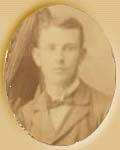 (5)
Norbert SIMON
(1871) was an building engineer who built roads & bridges and was
employed by the state in Transylvania. Originally, he worked in his
birth town Nagyvarad, but later he got in a job in Segesvár, also in
Transylvania. Norbert built the house his family lived in and had 7
children (the first one died): : Gyula
(1899), Lazlo (1901), Jolan
(1903), Klara (1906), Iren
(1910) and Magda
(1913). In 1919, after losing WWI, Hungary was forced to give up
Transylvania to Romania. Norbert, who was ethnically Hungarian, wanted
to stay within the borders of Hungary. Since Hungary was not accepting
Jews, Norbert converted his family to Lutheran and moved them to
Budapest. Norbert married open-minded and strong woman named Blanka
KONDOR. Blanka believed family came first and did much to instill a
strong sense of family in the Norbert SIMON line. Blanka opened a lace
shop. She also was a bit of a celebrity. She wrote books and had a
newspaper column on tips to women on how to run good households (she
would know!). The family prospered through the 20s, but in 1929 the
global depression hit. In the early 30s, as series of anti-Semitic
decrees put increasing restrictions on work, education and all facets
of life. Norbert died in 1939. His descendants live on in Hungary,
Austria and Israel. (5)
Norbert SIMON
(1871) was an building engineer who built roads & bridges and was
employed by the state in Transylvania. Originally, he worked in his
birth town Nagyvarad, but later he got in a job in Segesvár, also in
Transylvania. Norbert built the house his family lived in and had 7
children (the first one died): : Gyula
(1899), Lazlo (1901), Jolan
(1903), Klara (1906), Iren
(1910) and Magda
(1913). In 1919, after losing WWI, Hungary was forced to give up
Transylvania to Romania. Norbert, who was ethnically Hungarian, wanted
to stay within the borders of Hungary. Since Hungary was not accepting
Jews, Norbert converted his family to Lutheran and moved them to
Budapest. Norbert married open-minded and strong woman named Blanka
KONDOR. Blanka believed family came first and did much to instill a
strong sense of family in the Norbert SIMON line. Blanka opened a lace
shop. She also was a bit of a celebrity. She wrote books and had a
newspaper column on tips to women on how to run good households (she
would know!). The family prospered through the 20s, but in 1929 the
global depression hit. In the early 30s, as series of anti-Semitic
decrees put increasing restrictions on work, education and all facets
of life. Norbert died in 1939. His descendants live on in Hungary,
Austria and Israel.
|
|
(6) Emilia SIMON (1873-1875)
born & died in Nagyvarad at the age of 2.
|
|
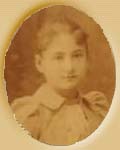 (7) Aranka
SIMON (1877) was a school teach who married merchant
from Kolozsvár. After completing high school at a
girl's academy, she assisted her father at the Auspitz. In 1900,
she married a merchant from Kolozsvár who was drafted and survived
WWI. When the Rumanians attacked Transylvania,
the family escaped from Alsórákos, She was cut
off from the rest of the family when the when the Oláhs (Romanians)
occupied Alsórákos around 1919. Aranka's descendants are the
only branch of the family to remained in Nagyvarad (now Oradea). (7) Aranka
SIMON (1877) was a school teach who married merchant
from Kolozsvár. After completing high school at a
girl's academy, she assisted her father at the Auspitz. In 1900,
she married a merchant from Kolozsvár who was drafted and survived
WWI. When the Rumanians attacked Transylvania,
the family escaped from Alsórákos, She was cut
off from the rest of the family when the when the Oláhs (Romanians)
occupied Alsórákos around 1919. Aranka's descendants are the
only branch of the family to remained in Nagyvarad (now Oradea).
|
Religion
Originally, the SIMON family were very
orthodox Jews. Abraham's parents were very orthodox and wanted him to study only
the bible, not laical subjects like German, Hungarian and arithmetic. With the
help of a Rabbi's daughter, Abraham broke with tradition and taught himself
sufficiently to become a principal of a school in Nagyvarad. By the time Abraham
was in Nagyvarad, he was a teacher for both the Orthodox and Neolog
communities. Although Abraham and his family are often referenced in the
temple records of the Orthodox temple run by Rabbi Landesberg, Abraham also
taught at the Neolog school of Adolf Auspitz and his eulogy was given by Rabbi.Kecskeméty
[Reformed].
The SIMON family found themselves in the middle of the
conflict between the Hungarians and Romanians. The SIMON's were ethnic
Hungarian, but Hungary lost Transylvania to Romania in 1918 as a result of the
treaty of Versailles at the end of WWI. Some members, like my grandfather
Jakab moved to Hungary prior to WWI and remained Jewish (he even let his
mother-in-law move in and keep a kosher kitchen in his household). His
brother Norbert was almost stuck in Romania and had to convert his family to
Lutheran in 1919 in order to move his family to Budapest. Their brother
Geza who was a hussar and later a Tobacco executive managed to get reassigned to
Budapest without changing religion and had his children bar-mitzvahed at the
Doheny St. Synagogue however he did experience persecution because of his
religion after the failed 1918 revolution. Sisters Ida and Aranka got
stuck in Romania.
My own grandmother Boske remained Jewish
but assimilated by marrying a Catholic (who was actually agnostic).
Boske's husband who was a politician converted his whole family to Unitarianism
after a falling out with the sisters in his daughter's religious school in 1934.
While my father never considered himself as a Jew, it is interesting that his
sister immigrated to Israel and became Jewish after escaping Hungary in the '56 revolution. |